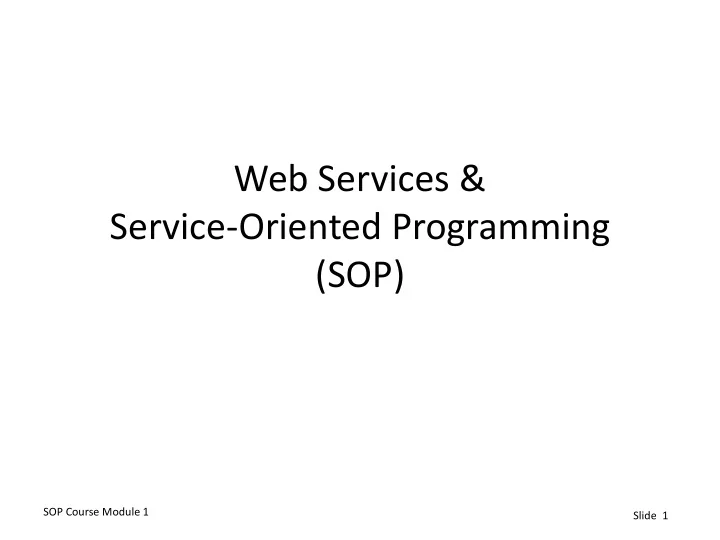

Web Services & Service-Oriented Programming (SOP) SOP Course Module 1 Slide 1
Service-Oriented Programming (SOP) • SOP – A programming paradigm that uses “services” as the building block to develop applications • Approach – Develop services (web) – Make use of services by invoking (calling) others – Combine services to make additional services SOP Course Module 1 Slide 2
What is a Web Service? • A service (high-level description) – Similar to a method -> a program calls a method and gets some results back • A web service (high-level description) – A service that can be invoked by a program via the internet. • A web service is different from a web application – A web application is for use by humans • Such as http://www.weather.com – A web service is for use by programs • Such as Twitter APIs: https://dev.twitter.com/rest/reference/get/followers/ids SOP Course Module 1 Slide 3
SOP Course Module 1 Slide 4
What is a Web Service? • Defined by World Wide Web Consortium (W3C): – A software system designed to support interoperable machine-to-machine interaction over a network. – It has an interface described in a machine-processable format (specifically WSDL). – Other systems interact with the Web service in a manner prescribed by its description using SOAP messages, typically conveyed using HTTP with an XML serialization in conjunction with other Web-related standards. SOP Course Module 1 Slide 5
Examples of Web Services • A self-contained business task – A money withdrawal or funds deposit service for a bank • A full-fledged business process with multiple tasks – Automated purchasing of office supplies with approvals at different levels • An application – A complete life insurance application • A service-enabled resource – Access to a remote database containing patient medical records SOP Course Module 1 Slide 6
What Web Services Bring to SOP • Traditional OOP constrained to homogeneity – Same data types, programming languages, development platform, operating systems • Web services handle heterogeneity – Makes extensive use of XML because XML has become ubiquitous – Accessibility through functionalities available on the web (standard networking and http) • SOP – Builds on web services to support software reuse SOP Course Module 1 Slide 7
Consuming a Web Service • The process of invoking a web service is known as consuming a web service. – Option 1 : The consuming program (client) sends a SOAP message to the web service. Both consumer and service use the same WSDL interface that describes the services provided. Contents of the sent/received SOAP message use XML format. – Option 2 ( RESTful service) : The consuming program sends a HTTP request operation (GET, PUT, POST, DELETE) based on the service to be invoked. The web service replies with an HTTP response. SOP Course Module 1 Slide 8
SOAP based Web Service Web Services publish their location and services (WSDL Interfaces) in a registry (UDDI). Clients consume services using the same WSDL Interface via a SOAP message. Web Services can act as both publishers and consumers. SOP Course Module 1 Slide 9
Consuming a RESTful Web Service • In a Representation State Transfer (REST) style architecture requests and responses are built around the transfer of representations of resources . • REST recognizes everything as a resource and each resource implements a standard uniform interface (typically HTTP interface). • Resources have names and addresses (URLs) • Each resource has one or more representation (like JSON or XML) and resource representations move across the network usually over HTTP. SOP Course Module 1 Slide 10
REST(ful) based Web Service SOP Course Module 1 Slide 11
Consuming a RESTful Web Service • All interactions between a client and a web service are done with simple operations. Most web interactions are done using HTTP and just four operations: – retrieve information (HTTP GET) – create information (HTTP PUT) – update information (HTTP POST) – delete information (HTTP DELETE) SOP Course Module 1 Slide 12
Consuming a RESTful Web Service • To invoke a RESTful API all you need is a browser or HTTP stack and pretty much every device or machine connected to a network has that. • Example of consuming Yahoo’s Finance API using Java’s HTTP centric classes: – https://gist.github.com/kocsenc/fd7febfda2f6eb8 dffb4 SOP Course Module 1 Slide 13
Recommend
More recommend